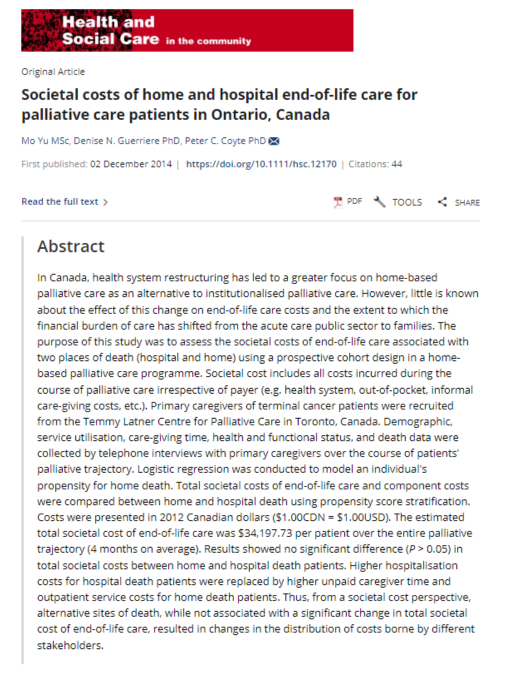Societal costs of home and hospital end-of-life care for palliative care patients in Ontario, Canada
Although patients in home-based palliative care had lower hospitalisation costs, they incurred much higher unpaid caregiver time costs and home care service costs than hospital-based patients. From a societal perspective, homebased palliative care may be just as expensive as hospital-based palliative care.
Author: Mo Yu MSc, Denise N. Guerriere PhD and Peter C. Coyte PhD
Publication Date: November 2015
Description: In Canada, health system restructuring has led to a greater focus on home-based palliative care as an alternative to institutionalised palliative care. However, little is known about the effect of this change on end-of-life care costs and the extent to which the financial burden of care has shifted from the acute care public sector to families. The purpose of this study was to assess the societal costs of end-of-life care associated with two places of death (hospital and home) using a prospective cohort design in a home-based palliative care programme. Societal cost includes all costs incurred during the course of palliative care irrespective of payer (e.g. health system, out-of-pocket, informal care-giving costs, etc.). Primary caregivers of terminal cancer patients were recruited from the Temmy Latner Centre for Palliative Care in Toronto, Canada. Demographic, service utilisation, care-giving time, health and functional status, and death data were collected by telephone interviews with primary caregivers over the course of patients’ palliative trajectory. Logistic regression was conducted to model an individual’s propensity for home death. Total societal costs of end-of-life care and component costs were compared between home and hospital death using propensity score stratification. Costs were presented in 2012 Canadian dollars ($1.00CDN = $1.00USD). The estimated total societal cost of end-of-life care was $34,197.73 per patient over the entire palliative trajectory (4 months on average). Results showed no significant difference (P > 0.05) in total societal costs between home and hospital death patients. Higher hospitalisation costs for hospital death patients were replaced by higher unpaid caregiver time and outpatient service costs for home death patients. Thus, from a societal cost perspective, alternative sites of death, while not associated with a significant change in total societal cost of end-of-life care, resulted in changes in the distribution of costs borne by different stakeholders.
Access: To read this article in full you will need to make a payment.
Keywords: end-of-life care, home care, palliative care, place of death, societal cost



